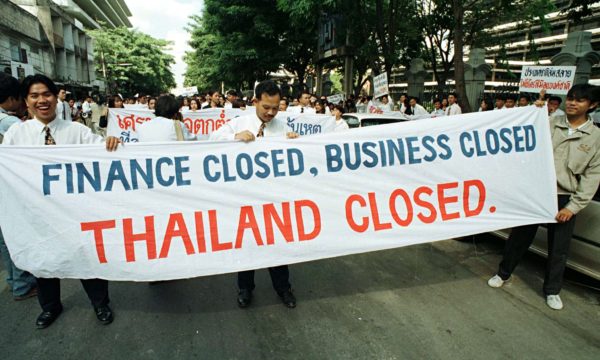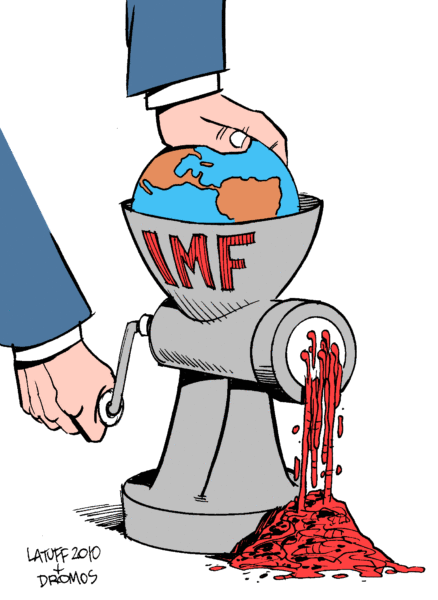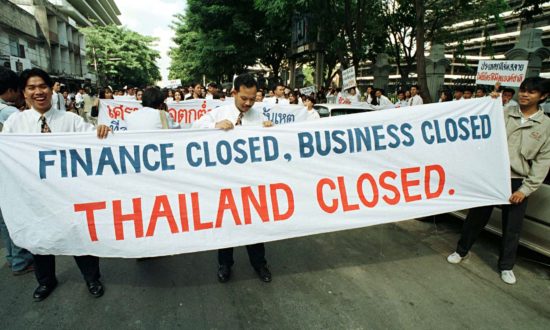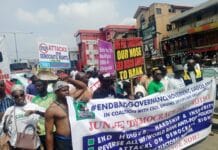Capitalism is preparing new catastrophes
chinaworker.info reporters
Twenty years ago the so-called ‘tiger economies’ of East Asia went into meltdown. The 1997 Asian Crisis narrowly missed dragging the world financial system into crisis, while inflicting mass misery on countries from South Korea to Indonesia. On 2 July 1997, Thailand was compelled to devalue the baht, an event that triggered a financial chain reaction across the region, with recession, soaring job losses and millions thrown into poverty over the next three years.
In Thailand, 2,000 jobs were lost every day. In South Korea, 1 million workers lost their jobs and large numbers of Seoul’s ‘salary men’ reportedly left home in their suits every day to sit in city parks, too ashamed to tell their families they no longer had a job.
In Indonesia, economic output fell by 14 percent in 1998, a bad situation made even worse by the policies of the International Monetary Fund (IMF). Wages fell by over one-third and 15 percent of male workers lost their jobs. An additional 80 million Indonesians were pushed below the poverty line. In May 1998, Indonesia’s dictator Suharto was overthrown. Other countries were convulsed by mass movements against the effects of austerity policies, with deep splits opening up within the ruling elites.
Today, the representatives of capitalism will claim that despite a “temporary wobble” capitalism passed this test, with East Asian economic growth rebounding strongly. Nothing could be further from the truth. Across the region today political systems are more unstable, with spiralling wealth inequality and rising discontent. Indonesia’s stock market is today eight times bigger than in 1997, but the country’s workers now have some of the lowest wages in the region – just one-third the level in China.
Thailand – where the crisis first erupted – has faced a prolonged period of social conflict raising the threat of civil war and the break-up of the country. The Thai generals have staged two coups in the past ten years and under current military dictator General Prayuth are rigging the constitution to insure a form of semi-military rule becomes permanent. In neighbouring Cambodia, dictator Hun Sen took power in 1997 and still rules today.
Malaysia and Indonesia are wracked by corruption while ethnic conflicts are deepening, whipped up by sections of the ruling elite to further their own power ambitions. In the Philippines, the coming to power of “Asia’s Trump” Rodrigo Duterte reflects a massive vote of no confidence in the entire political establishment and could in the future lead to a ‘Thai solution’ of military rule being attempted.

Emerging markets crisis
South Korea witnessed last year’s incredible “candle-light revolution” with 10 million joining mass demonstrations which toppled the former president Park. The workers’ movement and anti-capitalist moods had a strong presence in the Korean protests. Across the region therefore we see a new level of crisis and instability affecting all the capitalist regimes. This applies equally to Hong Kong, where GDP fell by 5.5 percent in 1998, and Taiwan, which again suffered long-term effects from the crisis.
The crisis of 1997 was also a precursor to the global crisis of 2008, and the European crisis of 2011 and onwards, with some obvious similarities in the ‘domino effect’ which rapidly spread the crisis from economy to economy.
Far from having overcome these problems, a new ‘emerging markets crisis’ hovers over global capitalism, fading for a time only to reappear with renewed menace. This is because the financial imbalances of global capitalism are more extreme than ever. Much of the ‘strong growth’ in Asia in the past decade is based on the cheap credit policies of Western central banks, unleashing a flood of speculative capital looking for higher profits in these markets. Asset bubbles (in property, stocks and so-called debt instruments) have formed, and these will at some point burst, with working people and the poor again being told to pick up the tab. As South China Morning Post columnist David Dodwell points out, “We have had two ‘once-in-a-lifetime’ crises in the past two decades, and a third in the next couple of years cannot be ruled out.”

The IMF’s role
During the Asian crisis, the IMF aroused mass opposition with its brutal austerity measures known euphemistically as ‘rescue packages’. Very similar policies of privatisation, deregulation and savage cuts in government programmes have been implemented in Europe in recent years, only with the IMF paradoxically questioning the more hardline stance of the European Union (EU) and its most influential member – formerly ‘social’ German capitalism.
Twenty years ago, the Asian Crisis brought forth the biggest IMF bailouts to date. But those sums have been dwarfed by more recent loans to Greece, Portugal, Ireland, Romania, and Ukraine, which today are the IMF’s biggest debtor countries (these ‘loans’ are used to pay back the blood-sucking Western banks with the costs imposed on the local population in the form of privatisations, pay cuts and other forms of austerity).
The ‘tiger economies’ were the miracle economies of global capitalism achieving annual growth rates of 6-8 percent from the 1980s onwards. In the early 1990s, however, an important shift occurred. These economies began abandoning the ‘Asian Road’ modelled on the rise of Japan in the 1960s-70s (a high degree of protectionism and state intervention) and under the pressure of US-led globalisation removed controls on foreign capital and other forms of government regulation. Local capitalism had ‘matured’ in the sense of becoming increasingly financial and parasitic, as overcapacity and greater use of technology squeezed other – productive – sources of profits.
Before 1997, the IMF was instrumental in creating the conditions that led to the crisis. It then stepped in with ‘bailouts’ which made the effects of the crisis even worse, through brutal austerity measures à la Greece today. This was during the heyday of neo-liberal globalisation under Bill Clinton’s presidency. The IMF acted as an extended arm of US foreign policy. The furious blowback against the IMF’s failures during the Asian crisis led to a change of style, and forced a rethink over some of its more market fundamentalist approaches. It would be wrong to conclude however that the leopard has, or indeed can, change its spots.
Thailand
IMF-critic, nobel laureate and former World Bank chief economist, Joseph Stiglitz, bemoaned the US Treasury’s influence over IMF policies in Asia. Stiglitz described the US Treasury as “Wall Street’s handmaiden”, pointing out the lifting of capital controls in Asia in the 1990s was a key demand of US financial conglomerates.
In 1992, for example, Thailand set up an offshore banking centre with IMF backing and encouraged a lucrative ‘arbitrage’ business whereby money was borrowed at low rates in New York or Tokyo and deposited in Thai banks at a higher rate of interest. The pegging of the Thai baht to the dollar made this a largely risk-free affair for speculators. By 1997, there was US$56 billion deposited in this way in Thailand, triple the 1994 level.
From mid-1995, the US dollar began a dramatic rise, putting its satellite currencies in Asia under pressure. Thailand’s current account deficit soared, puncturing the country’s property and stock bubble and leading to a surge in private sector debt. The crisis that followed spread to Taiwan, Hong Kong, South Korea, Indonesia, Malaysia and the Philippines, later dragging down Russia and Brazil. US$100 billion in capital flight – ten percent of combined GDP – exited the five worst-hit Asian countries in 1998.

South Korea
In 1998, under the boot of its IMF bailout, South Korea abandoned limits on foreign ownership, allowing foreign capitalists to buy up national champions like car and electronics companies. The government of Kim Dae Jung, elected at the stormiest point in the crisis, opted for an ‘IMF Plus’ policy involving additional and faster market reforms than even the IMF had pressed for. The South Korean banks were saved – costing a staggering 31 percent of GDP – while permanent jobs were destroyed and replaced by lower paid and inferior temporary contracts.
Aside from their obvious mistakes – aggravating the crisis with sky-high interest rates and brutal austerity measures – IMF and World Bank economists invariably misread the economic signals. In July 1997, in the wake of the Thai crisis, the World Bank thought Indonesia’s economy, “relatively well equipped to cope” and deemed the risk of a serious economic shock as “currently very low”. In November 1997, an IMF report judged South Korea to be “essentially safe”, because its economic “fundamentals remain strong”. Less than a month later Seoul was signing up for the biggest IMF package so far. The IMF program for Thailand was based on projections of 3.5 per cent growth in 1998, when in fact the economy contracted by ten per cent!
The IMF rescue packages during the Asian Crisis – $17 billion for Thailand, $33 billion for Indonesia, $55 billion for South Korea, $22 billion for Russia and $41 billion for Brazil – represented a new departure: They were bigger and contained far more conditions than previous ones. As with the much bigger packages for Greece in the past seven years, they failed in their immediate objective: to calm financial markets.
Robert Rubin, President Clinton’s Treasury Secretary, phoned IMF chief Michel Camdessus who was personally negotiating with the South Korean government in 1997 and delivered “an extraordinarily blunt, unequivocal warning that the United States would not countenance what it regarded as a weak program,” according to Paul Blustein in his bestselling book The Chastening – Inside the crisis that rocked the global financial system and humbled the IMF (Public Affairs, 2001). This pressure from the Clinton administration, representing Wall Street’s interests, provoked unprecedented tensions which are one factor behind today’s geopolitical shifts and the weakening of US influence in Asia, which is also reinforced by China’s rise.
Bank closures
Under IMF policies, Thai unemployment tripled and urban wages fell by 8 percent. The severity of the downturn even prompted the IMF to think again and urge the Thai government to adopt a budget deficit: “something I never thought I’d hear us say”, commented one IMF economist. In August 1997, the IMF initially opposed the Thai government’s plan to initiate a deposit guarantee scheme to protect Thailand’s banks against panic withdrawals.
The government’s position prevailed and “kept the Thai banking system from utter collapse” according to one IMF official, in stark contrast to what happened in Indonesia. There, the IMF opposed a similar scheme pushing instead for bank closures. Half the country’s businesses went bankrupt as a result. A 1999 IMF report conceded that its policy in Indonesia “now appears to have been ill-advised”.
Thailand’s Finance Minister complained “the time will come when no IMF staffer will be able to come to Asia”. His government, and South Korea’s, initially approached the Japanese government for an emergency loan before being forced to seek IMF help. Japanese capitalism saw the crisis as an opportunity to further its continental ambitions, playing the card of ‘Asian unity’, but its ability to do so was checked by the dire state of Japan’s banking sector.
If Japan had been in a position to organise its own ‘rescue packages’ for the crisis countries the results would not necessarily have been so different – on the basis of capitalism and its ‘profits-first’ rationale. Possibly, this would have involved a more gradual approach towards austerity measures, but as we have seen in Japan itself after two ‘lost decades’, several recessions, and a banking crisis, it is the working class has been made to pay for the failings of capitalism, with increased poverty and an explosion of outsourcing and temporary contract labour, which today stands at a world record 37.5 percent of the total labour force.

US-Japan conflict
Blustein’s book describes a conflict between the US and Japan during the sharpest phase of the crisis. Washington viewed Tokyo’s intentions with suspicion because it “feared the IMF’s central role in crisis-fighting might be undermined”. The Clinton administration wanted to block Japanese capitalism using the crisis to dislodge the US from Asia and organise a regional bloc under Tokyo’s domination, similar to Germany’s position in the EU. Japan’s vice finance minister, Eisuke Sakakibara – known as Mr Yen – drew up plans to launch a “gigantic hard-currency fund that would use a portion of the hundreds of billions of dollars in reserves” held by Japan, China and other countries.
This proposal, for an ‘Asian Monetary Fund’ (AMF), encountered fierce US resistance. Mr Yen sent an “unofficial” outline of his plan to South Korea, Malaysia, Hong Kong, Singapore and Indonesia in September 1997. Blustein notes, “the documents weren’t intended for American eyes”.
The Clinton administration launched a determined counterattack. Larry Summers (then Rubin’s deputy at the US Treasury) warned Sakakibara he had “violated” the rules of US-Japanese engagement. Washington sent officials to Asian capitals warning governments not to indulge the Japanese plan. While Malaysia, the Philippines and Thailand supported the plan, Australia and – crucially – China were against.
The Chinese dictatorship was also anxious to check Japan’s regional ambitions. In the 1990s, China was still heavily dependent on trade and other economic deals with US capitalism, primarily China’s drive to join the WTO which it achieved with US support in 2001. China was not then in a position to mount its own push for regional hegemony, as it is now doing, based on the changed balance of forces between Beijing, Washington and Tokyo since the 2008 crisis.
Long Term Capital Management
The turning point in the Asian Crisis came from a partial u-turn in policy by the US itself, which feared the crisis was spreading to the US financial system. The flashpoint was the collapse of hedge fund Long Term Capital Management. LTCM’s bankruptcy represented a threat of incalculable dimensions to Wall Street and the global financial system. US giants Bankers Trust and Lehman Brothers (!) were also in trouble.
Fed (central bank) chairman Alan Greenspan’s judgement was that the collapse of LTCM “could have potentially impaired the economies of many nations, including our own.” Essentially this was an anticipation of what happened at Lehman Brothers a decade later. Lehman however was allowed to collapse, enormously aggravating the global crisis.
In 1998, the US government did what it had so often insisted Asian governments should not do, and propped up an insolvent financial institution. Central banks everywhere followed a US call to cut lending rates and pump liquidity into financial markets. The US action erected a ‘firewall’ against the spread of the Asian Crisis (which had already spread beyond Asia) and a global crash was averted.
But what happened next? As we know capitalism was incapable of learning – or changing – after the crisis of 1997-98, and so stumbled into the even bigger and more destructive crisis of 2008 and beyond.
Today, the state of global capitalism is akin to a ‘zombie’ economy. A worldwide depression has been averted by unprecedented ‘money printing’ measures (quantitative easing and zero interest rates) which however have not succeeded in sparking a real recovery and which governments are finding it hard to exit from. Political instability, an explosive voter backlash against neo-liberal globalisation, and the crumbling authority of all capitalist institutions – from national governments to the IMF and EU – are enormously complicating economic problems.
As in the 1997 crisis and its aftermath, the most important development will be the growth of mass opposition to capitalism and the building of workers’ organisations. Only socialist policies offer a way out.




